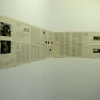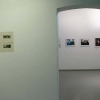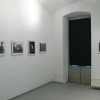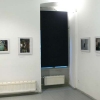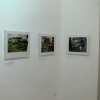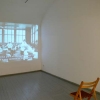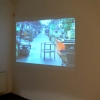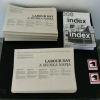Warning: preg_match(): Compilation failed: invalid range in character class at offset 34 in /var/www/labor.c3.hu/wp-content/plugins/nextgen-gallery/products/photocrati_nextgen/modules/nextgen_basic_tagcloud/package.module.nextgen_basic_tagcloud.php on line 183
| 2008. Apr. 29 – May. 23 |
Fragment #6: Labour Day
 Opening: 7 pm 29th April 2008
Opening: 7 pm 29th April 2008
The question we put to ourselves in the autumn of 2006 was a relatively simple one: What has happened in the twenty years since the fall of the Iron Curtain to us, to the artistic imagination, to society? How are we to relate today to the twenty-year period of transformation that we were, and still are, part of?
In each exhibited fragment we attempt to map various aspects of changing societies. In the Labour Day exhibition we focus on changes with regard to work. The exhibition symbolically overlaps the Labour Day holiday celebrated on May 1st. The socialist regimes placed an enormous ideological emphasis on this holiday as work was for them one of the most important motives on which they rested their power. Over the past twenty years, however, most of the values from that time connected to work have died out and a new concept of work in a liberally capitalist society has brought changes that have strongly affected the lives of people across the social spectrum. The artists invited to exhibit reflect these changes and try to capture the lives of individuals who, for instance, buy a turning lathe from a factory where they worked their entire lives (J. Skála ) create a nostalgic picture of a once lively and now closed canteen where an artist enabled the meeting of former workers in a somewhat strange commemorative ritual (G. Makarevicius). In the video by Ciprian Muresan, a John Cage composition clashes with an empty production hall void of workers, and becomes merely a conceptual work playing out in the viewer’s mind.
A booklet has been printed in which renowned Czech philosopher Václav Bělohradský ponders what remains from the “work song” in today’s world and what has become of work at present.
Zbyněk Baladrán, Vít Havránek
Gintaras Makarevicius
Hot
(12 min (Mini DV), b/w, colour & sound)
An abandoned factory canteen, typical of the 60s and 70s, has inspired the idea to revive and reconstruct the memory of the real people who used to work in the factory. Authentic dishes of the 60s and 70s are served, the people who used to work and have lunch there are invited, and their stories about that time are heard. Four toasts made during the lunch became the basis for editing the video film.
Gintaras Makarevicius (b. 1965 in Trakai, Lithuania) studied painting at the Vilnius Academy of Arts 1988-1994.
Jiří Skála
Two Families of Objects
(2006-2007)
In 2001, my mother, Jiřina Skálová, received a turning lathe, on which she had worked for nearly 22 years, as a present on her 50th birthday. My father Jaroslav Skála bought it for her from the factory where she had worked, which was going bankrupt and was selling off all its equipment to pay its debts to the bank. The factory managed to make it through the early transformation process of the 1990s, but at the beginning of the new century it evidently ran out of breath. My father decided to insure their future by purchasing the turning lathe – equipment that would allow them to continue to keep on working and earning. I asked my mother to photograph this unusual present and to give me the photograph. After this I got to know from my parents that there are other people who have found themselves in similar
situations – those who have purchased the production equipment, on which they had worked most of their lives during the communist regime, from now defunct companies and producers. I sought these people and asked them to photograph the machinery themselves and give it to me. The final product is a series of photographs named after that essay. The series features 14 colour photographs, 50 x 40 cm big and they are in plexiglass frames.
Jiří Skála (Born 1976 in Sušice) lives and works in Prague. Studied 1998-2004 at the Academy of Fine Arts, Prague
Ciprian Muresan
4‘33“, (after J.Cage)
(dvd pal, 2008)
In the video by Ciprian Muresan, a John Cage composition clashes with an empty production hall void of workers, and becomes merely a conceptual work playing out in the viewer’s mind.
Ciprian Muresan (born in 1977), lives and works in Cluj co-editor of VERSION artist run magazine from 2005 editor of IDEA art + society magazine

